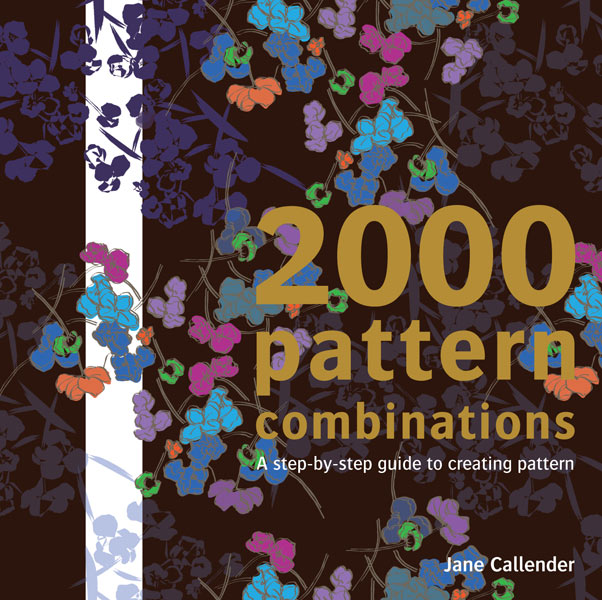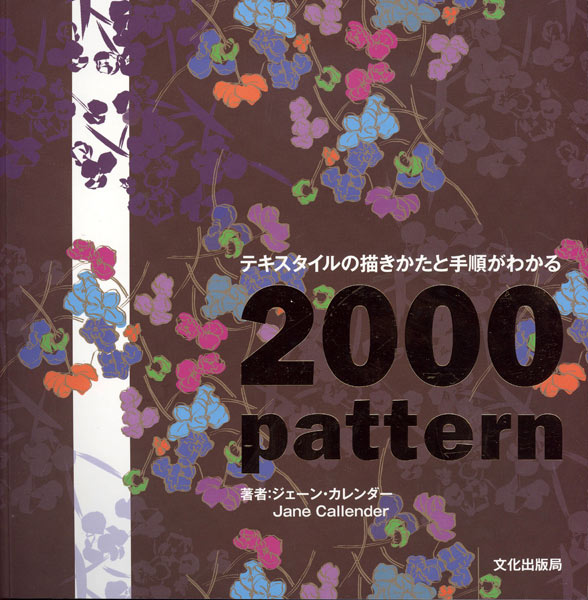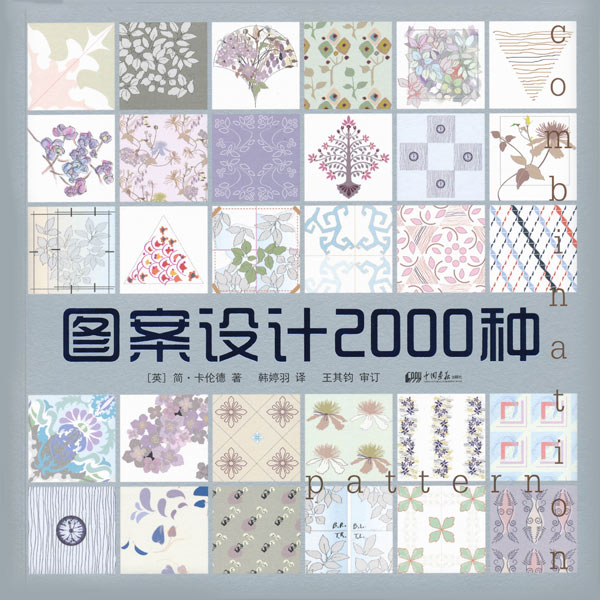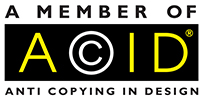2000 Pattern Combinations by Jane Callender
This title is now out of print. However it can be sourced on other websites and book search sites.

English Edition

Japanese translation

Chinese translation
Pattern can be as expressive as music, as transient as breeze, or as stern as granite; it can lift the spirit or take it to a more sombre place.
‘The book is about placement of line and shape rather than mark making, or the quality of marks.’ From the introduction by Jane Callender. Full introduction can be seen below along with images from the book.
Pattern has made a terrific comeback in the last decade and its popularity shows no signs of abating. Pattern design is booming in the craft, textile, fashion and graphic design worlds. This is a much-needed book on simple and more advanced ways of creating pattern, with a plentiful source of colourful combinations that you can use to further your own creative work. ‘This is a visually rich book that has applications for any kind of designer’
Publication information
Published: September 2011
Publisher: Batsford, Anova Books
RRP: £20
ISBN:9781849940078
336 pages
2000 illustrations
220 x 220 mm square format
Also co-published in Japan with Japanese text.
Pub. Bunka Shuppan Feb 2013
Also published in Mainland China in Chinese Simplified Characters.
Pub. Chinese Pictorial Publishing
Ways to buy
2000 Pattern Combinations is currently out of print.
However, a few copies are available to buy on Amazon
A must-have guide to creating and developing your own professional and unique patterns, whether you are working in craft, textiles, fashion or graphic design.
Simple step-by step instructions and clear illustrations demonstrate each stage of the design process, from simple repeating and reflecting combinations to more complex techniques for disguising the repeat.
Whether you are working with simple squares or triangles or more complex floral and animal designs, you can create beautiful patterns from a range of source material.
Illustrated throughout with the author’s own inspirational pattern designs, the book is packed with ideas for adapting and developing your patterns for any medium, and will show you how to take your designs to the next level.
The book includes a chapter devoted to patterning with stitched shibori motifs which offers many insights into the technique.
Jane Callender is an award-winning shibori artist and recognised shibori master with a passion for pattern. After gaining a BA (hons) degree in printed textiles her continued exploration of pattern-making led her to develop the shibori work for which she is known.
Now on the essential reading list of University of Creative Arts, Surrey.
Reviews
Anna Dolanyi of the Hungarian Quilters Guild
Translation from Hungarian by Gyorgy Jaros
The name of Jane Callender has a familiar ring to those who had the good luck to participate in her ‘Introduction to Shibori’ in the Textile Museum (Budapest) in 2009. Originally she became famous – we can say even world famous – and multiple prize winner for her creations in Japanese blue dyeing techniques (shibori). Now she surprised the textile world with such a book that is equally important and will be useful for people who are active in other disciplines, be it graphic artists, textile designers or industrial artists not to mention practising quilters. It has the aim of aiding original individual creation of pattern. Starting from the simplest forms the book goes step by step from simple to complex patterns. 2000 illustrations help to make the creation more visual and understandable. The majority of the illustrations are in colour and even browsing is already an experience. The book is not recommended for beginners; nevertheless it is a basic work which cannot be ignored by those who want to create their own designs.
Jilly Szaybo for Galleries.co.uk
Most book-lovers talk about the pleasure of feeling the ‘heft’ of a book and of the many reasons for not turning digital. Jane Callender’s ‘2000 Pattern Combinations’ may not have the most alluring title, but the remarkably inspiring contents within the satisfying weight and shape of this Batsford publication makes it a ‘must have’ for artists of many disciplines. Callender in her excellent introduction, suggests these might be, among others, embroiderers, ceramists, glass engravers, as well as her own craft of shibori textile design, but I would include painters as well, for the complexity and richness of pattern in this book by far transcends any ideas of regularity and repetition. Callender is herself a distinguished shibori master, shibori being the Japanese term for the many methods of dyeing and stitching cloth into intricate patterns. She was initially trained in textiles at Farnham Art School by teachers who had in turn been taught textile design by the two startlingly original modernists – Barron and Larcher – famous from the 1920s. And so the line of arts and crafts continues as does the fascination for potentially limitless pattern, for which Callender has designed hundreds of computer generated starting points and step-by-step developments for use in any medium.
A wonderful book.
Maggie Grey for Workshop on the Web
This is a great guide for all those wanting to create their own patterns. The step-by-step instructions take the reader through simple patterns – repeats and reflections into far more complex techniques. Working from geometric through to floral, African and random design sources, Jane shows how pattern exploration works, whatever the source material. The book concentrates on placement of line and shape and, although all the patterns in the book are computer created, it is entirely possible to use any number of alternative media. Jane, being a shibori specialist, has also included a chapter on this subject.
Eleanor Milne
I am fairly new to the technique of developing illustrations into repeat patterns and have found your book a fantastic guide. It takes you through the stages with clarity and ease. Thank you for this book which is not only educational but also inspirational.
Janet Crowther, Textile tutor, UK
I have a copy of your book and it is brilliant! I took it to show the students at Urchfont Manor and they were very impressed. It was the ‘pattern’ weekend and was so useful.
2000 PATTERN COMBINATIONS INTRODUCTION
A step by step guide to creating pattern
By Jane Callender
Pattern can be as expressive as music, as transient as breeze, or as stern as granite; it can lift the spirit or take it to a more sombre place. It has become a fascination for me over the years, providing a sound discipline for my stitched shibori.
We encounter pattern design on different surfaces on a daily basis. Even smooth white sheeting has pattern, the organisation of warp and weft threads in a plain weave, more easily seen in basketry, is pattern born out of construction. For pattern designers, never before has there been such a vast selection of techniques, enticing media or materials to work with or so many diverse sources for inspiration. With current weaving, transfer and printing technology designer’s patterns can be interpreted in a myriad of different ways and applied to any number of surfaces.
Pattern is created by the repetitive placement of a motif or design in a systematic way. The pattern maker uses geometric grids to ensure the placements are methodically accurate, which in turn allows the pattern to flow without interruption or disturbance of rhythm. This regularity of placement is known as the repeat, and a pattern can be ‘put into repeat’ in a number of ways. On a two dimensional surface pattern can be regarded as potentially limitless. Man alone produces infinite pattern; pattern in nature, while offering infinite inspiration, is restricted to shape and form. After all, fish scales alter in size and are tailored to suit the fish!
The most popular shapes for grids are the square and triangle and many options arise when these are used in combination. The scale and ogee offer alternatives, and all provide the armature or skeleton into which motifs and designs can be placed. Using grids may seem like a restrictive process but they are liberating for the pattern maker. The main consideration is the actual surface onto which the pattern is eventually to be placed; for example, the tile size or fabric width – is it for fashion or furnishing? The pattern needs to be made ‘fit for purpose’, in other words absolutely suited for its intended use with scale, colour, motif design and layout all working together to enhance the product and buyers, when choosing designs, more often than not request that they are presented ‘in repeat’ and in various colour ways.
This collection demonstrates many aspects of patterning and offers more than just patterns to copy. Using the easy-to-follow, step-by-step illustrations and text guide lines readers can start setting up patterns of their own choice. A story board is included on the practical steps involved in putting a design into repeat. Many options crop up in the varying themes, each focussing on a different aspect of the repeat. As a design is developed the process is outlined and changes discussed en route. It shows how complex patterns can evolve from simple beginnings.
Specific headings such as brick repeat; rotation repeats etc, are not used except in the introductory chapters 1- 4. Rather, all these variations are encountered under a pattern’s name. Thus in ‘The Duck’ repeat formats, development schemes, colourways and scale will be found as the pattern unfolds on the page. One would assume that ‘The Duck’ would bring forth endless patterns of ducks, but as tweaks and amendments are made, the emergence of a 1940’s pastel geometric style pattern is not such a surprise after all!
The book is about placement of line and shape rather than mark making, or the quality of marks. All the patterns have been created on the computer in an attempt to create neutrality and to disconnect from any specific style. I hope that the reader will interpret line, the infill of shape and scale in a personal way. Thus a line may become a hand stitched line in the eyes of an embroiderer or an inscribed mark by the ceramicist; a shape as leather appliqué or as paint applied through a stencil. Certain patterns bring woven textures to mind; others evoke engraved glass. I have included a chapter on shibori as, though this technique is very different, it benefits from pre-planning with pattern making principles. Even here pattern drafts are open to interpretation.
This pattern collection is a lexicon on which a designer, in whatever discipline, can draw for their own particular purpose and intended surface. I hope that students embarking on a career in design and pattern making will find it a useful text book and that it will inspire and be a point of reference for those wishing to decorate any number of different surfaces. What unites us is a love of, and delight in the enduring and enriching quality of pattern, the desire to discover their hidden correlation and a need to express our own unique vision.
A LOOK INSIDE – IMAGES FOR 2000 PATTERNS
Chapters ‘Moving the Square’ and ‘Moving the Triangle’ explore their use as container units for a design, with combination formats dealing with scale and pattern development.
Through abstraction from the selection of shapes a duck provides the starting point for a series of motifs and patterns.
Opacity is explored and a design is adjusted for the repeat placement. Together they create a soft edged misty pattern.
Developing motifs, sprigs and a design to be put into repeat. A chapter on disguising the repeat illustrates all the requirements, adjustments and practical steps needed to put a design into repeat. A floral is given a more contemporary look.
Simple shapes lead to more complex patterns. Colour dynamics for patchwork squares are examined and there are many ways to treat a spot or sateen repeat.


